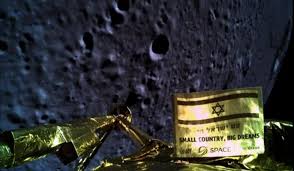Source: thewire.in
New Delhi: Even before India’s much-touted lunar missing, Chandrayaan-2, lands on the moon, a very small biological sample from the country may already be there.
According to The Hindu, this is because the only likely surviving payload onboard the Israeli lunar lander Beresheet, called the Lunar Library, contained a leaf and some soil from the Bodhi tree in Bihar.
Beresheet, whose name is Hebrew for the biblical phrase ‘In the beginning’, was launched on February 21 on board a SpaceX rocket. On April 11, it crash landed on the moon after a series of technical failures during its final descent. It was reported then that the Lunar Library, created by the Arch Mission Foundation (AMF), was likely the only payload that wasn’t destroyed in the crash.
But what is this Lunar Library, and why was it carrying Indian soil?
The Library, according to the AMF, “contains a 30 million page archive of human history and civilisation, covering all subjects, cultures, nations, languages, genres, and time periods”. It’s meant to be a “backup” of life on Earth, in case of human extinction.
It “is housed within a 100 gram nanotechnology device that resembles a 120mm DVD. However it is actually composed of 25 nickel discs, each only 40 microns thick,” AMF says.
Nova Spivack, co-founder of the AMF, told The Hindu in an email that a small sample from the Bodhi tree, along with material on learning Hindi, Urdu and information on music, were a part of the Lunar Library. He said:
“The management of Mahabodhi stupa (Bihar) privately gave me a leaf from the Bodhi tree and some soil from under the Bodhi seat. These were included. We mixed these with relics from saints and yogis, as well as earth from sacred caves and tiny bits of relics from India, China, Bhutan, Myanmar, Thailand, Vietnam, Nepal and Tibet.”
This isn’t the startling revelation Spivack has made about what the Lunar Library contains. Last week, he revealed that thousands of tardigrades – microscopic creatures commonly known as “water bears” – are also a part of this backup. Tardigrades are known to be some of the most resilient creatures on Earth. As The Wire has reported before, they have been known to come back to life even after being exposed to radiation in space and being frozen for several years.
On the AMF website, the organisation had earlier revealed the some of the contents of four analogue layers and 21 “layers of 40 micron thick nickel foils, each containing a DVD master”. This included private archives on culture and music, thousands of PDFs of books, linguistic datasets and more.
Even then, though, the foundation had made it clear that there was more than it was saying. “But this is only the beginning of the story – there is in fact much more in the Lunar Library. This will be revealed in coming months and years,” it said.
